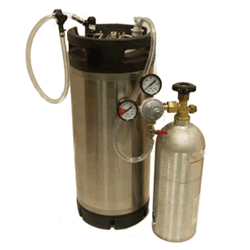CO2 saturation is an important nuance of many beers. Most beers have an ideal temperature and CO2 level that they should be served at for optimal taste. If the keg set up is even off by as little as 2 PSI of CO2 or beer gas, it can drastically affect the taste and texture of the beer being served.

A good understanding of the basic principles of beer carbonation will help a beer fan to know when a beer is being served properly or maybe more importantly, to know how to ensure that any home draft beer system is dialed in for the specific beer being served.
See our Dialing-In your Home Draft System guide to the perfect pour.
If you aren’t sure how carbonated your beer is or haven’t really thought about that aspect of beer drinking too intently, here’s the basic rule: lighter, less flavorful beers generally have more carbonation than rich hoppy or malty beers. This guideline isn’t 100% true, but it is fairly universal. What complicates matters is that the volume of CO2 that is absorbed into the beer can vary greatly depending on the temperature of the beer or keg. This is because the amount of CO2 or beer gas that is absorbed into the beer goes down as temperature goes up. Likewise, the amount of CO2 or beer gas that is absorbed into the beer can go up if the temperature goes down. Thus, problems arise when the temperature of the keg raises or lowers from the manufacturer’s specifications.
Fortunately, there is a rule of thumb that can help you to dial in a draft beer system so that the resultant beer tastes pretty close to what is the ideal pour, even if your temperature is a little bit off. If you are dialing in a home draft beer system, and you find yourself needing to serve beer when the keg isn’t at the ideal temperature, you can balance this out by increasing the PSI of the beer gas by +1 PSI for every two degrees Fahrenheit of temperature that the keg has gone down from the ideal temperature. This is because the beer is absorbing more CO2 gas into itself, thereby reducing the in line and in keg pressure. Similarly, you can adjust the pressure down –1 PSI for every two degrees Fahrenheit that the keg has gone up from the ideal temperature. This is because CO2 gas is escaping from the beer and causing more pressure in the keg’s headspace and lines.
 |
Home beer makers may wonder what temperature and pressure they should specify for their homemade beer? One answer I can figure is to look at the manufacturer’s specifications for a variety of beers and pick out the specific beers that share the most flavor and body characteristics with the beer you are making. There can be a lot of difference even within types of beer. For example, if the beer in question is a pale ale, does it have a light or heavy body? Is it hoppy or is the hop character slight?
When inquiring about serving pressures for different types of beer it is important to make the distinction between the proper pressure for beer gas and for CO2. Beer gas is the mixture of CO2 and Nitrogen which is used by most commercial draft serving establishments, which is usually mixed by a specialized gas mixer that is hooked up to two separate tanks, one containing CO2 and one containing N (Nitrogen). Beer gas is available pre-mixed in tanks for home draft systems, but at a significantly greater cost than CO2.
Beer gas functions significantly differently than CO2 when pushing beer. The end result is that the beer tastes smoother when it is served with the beer gas mixture and in some ways the beer gas mixture is more forgiving in terms of foaminess than straight CO2.
To understand how CO2 permeates and effects the taste of different beer types, we need to understand the beer industry’s codification of this attribute. The carbonation level of a given beer is rated in terms of CO2 volumes. The lower this number is, the less carbonated the beer is.
The following is a guide that can help you to determine the ideal temperature and pressure to use for commercial kegs and home brew. This guide is in terms of straight CO2 instead of beer gas, which is often a mix of CO2 and Nitrogen:
Most home draft beer dispensers work well at between 9-12 PSI for serving, but the numbers above may need to be adjusted according to the length of the beer line, temperature variations, etc. There are a lot of other variables, too. For example, beer can be foamy and difficult to serve if the keg has not had time to settle after transport. The type of beer lines used in the draft system can have an affect, as well as the length of the beer lines. Generally, it is better to start at the low end of the pressure range and work up to the ideal pressure, but keep in mind that the symptoms of a maladjusted draft system can be very similar whether there is too little pressure or too much. In the case of too little pressure, the CO2 is being pushed out of the beer by the atmospheric negative space, while if there is too much, then the beer is over saturated with CO2 and the gas is being pushed out by the difference between the closed system’s pressure and the pressure outside the draft system.





